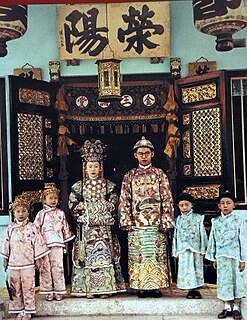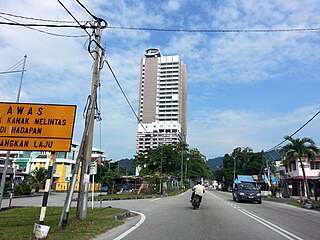
Penang is a Malaysian state located on the northwest coast of Peninsular Malaysia, by the Malacca Strait. It has two parts: Penang Island, where the capital city, George Town, is located, and Seberang Perai on the Malay Peninsula. They are connected by Malaysia's two longest road bridges, the Penang Bridge and the Sultan Abdul Halim Muadzam Shah Bridge; the latter is also, as of May 2019, the longest oversea bridge in Southeast Asia. The second smallest Malaysian state by land mass, Penang is bordered by Kedah to the north and the east, and Perak to the south.

George Town is the capital city of the Malaysian state of Penang. George Town is Malaysia's third most populous city with 708,127 inhabitants as of 2010, while Greater Penang, with a population of 2,412,616, is the nation's second largest conurbation in the country after Greater Kuala Lumpur. The historical core of George Town has been inscribed as a UNESCO World Heritage Site since 2008.

The Peranakans are an ethnic group defined by their genealogical descent from the first waves of Southern Chinese settlers to the ports in the Malay Peninsula and Indonesian Archipelago. Peranakan culture, especially in the dominant Peranakan centres of Malacca, Singapore, Penang and Medan is characterized by its unique hybridization of ancient Chinese culture with the local cultures of the Nusantara region, the result of a centuries-long history of transculturation and interracial marriage.

Islam in Malaysia is represented by the Shafi‘i version of Sunni theology and jurisprudence, while defining Malaysia constitutionally a secular state. Islam was introduced by traders arriving from Arabia, China and the Indian subcontinent. It became firmly established in the 15th century. In the Constitution of Malaysia, Islam is granted as the "religion of the Federation" to symbolize its importance to Malaysian society. However, other religions can be practiced freely. Close to 7% adhere to smaller branches.

Penang Island is the main constituent island of the Malaysian state of Penang. Located in the Strait of Malacca, off the northwestern coast of Peninsular Malaysia, it is separated from the mainland by the Penang Strait. The island is home to nearly half of Penang's population; the state capital George Town, which covers the island and the five outlying islets, is Malaysia's third-largest city by population.

The Kapitan Keling Mosque is a mosque built in the 19th century by Indian Muslim traders in George Town, Penang, Malaysia. It is situated on the corner of Buckingham Street and Pitt Street. Being a prominent Islamic historic centre, it is part of the World Heritage Site of George Town and lies at the centre of the city's Tamil Muslim neighbourhood, the chulias. It is the first permanent Muslim institution to have been established in the area, dating from the early 1800s. Cauder Mohuddeen Merican is known as the founder of the mosque and leader of the Chulias. In 1801 Sir George Leith, who was then Lieutenant Governor of Penang, appointed a prominent Indian Muslim leader, Cauder Mohudeen, as Captain of the South Indian “Keling” community. He granted a piece of land to build a mosque on the south side of Malabar Street. Cauder Mohudeen was a ship mandoor or foreman from Porto Novo, which the Tamils called Paringgipettai and the Muslims Mahmudbandar, about 50 kilometres south of Pondicherry in India. He was referred to as 'Kapitan Kling'.

Lebuh Aceh Mosque is a 19th-century mosque built by the Acehnese situated on Acheen Street, George Town, Penang, Malaysia.

Bukit Mertajam is the administrative centre of the city of Seberang Perai in Penang, Malaysia. It also serves as the seat of the Central Seberang Perai District. As of 2010, Bukit Mertajam (core)contained a total of 13,097 residents.

Nibong Tebal is one of the major town of the city of Seberang Perai, Penang, Malaysia. Located at the northern bank of the Kerian River in South Seberang Perai District, it is the southernmost populated place of Penang. Nibong Tebal contained a population of 2,045 as of 2010.

Ayer Itam is a suburb of George Town in Penang, Malaysia. Nested within the central valleys of Penang Island, it is located approximately 6 km (3.7 mi) southwest of the city centre. Ayer Itam is one of the well-known places to sample Penang cuisine, and includes a handful of major tourist attractions such as Penang Hill and Kek Lok Si Temple.

Gelugor is a southern suburb of George Town in Penang, Malaysia. Named after a plant species, Gelugor lies along the eastern seaboard of Penang Island, between Jelutong and Sungai Dua, and nearly 5 km (3.1 mi) south of the city centre.

Teluk Kumbar is a town within the city of George Town in the Malaysian state of Penang. It is located within the Southwest Penang Island District, at the southern coast of Penang Island between Bayan Lepas to the east and Gertak Sanggul to the west.
The Jawi Peranakan is an ethnic group found primarily within the Malaysian state of Penang and in Singapore, both regions were part of the historical Straits Settlements where their culture and history is centred around. The term "Jawi Peranakan" refers to locally born, Malay-speaking Muslims of mixed Indian and Malay ancestry. Over time, this has grown to include people with Arab ancestry as well. They were an elite group within the British Malayan community in mid-19th century Malaya. In addition to their substantial wealth and social standing, they are remembered for setting up the first Malay newspaper in Malaysia, Singapore, Indonesia and China, the Jawi Peranakan and their influences on Malay culture.

The Penang State Museum and Art Gallery is a museum and art gallery in George Town, Penang, Malaysia.

The Camera Museum is a museum in George Town, Penang, Malaysia.

The Penang Floating Mosque, also known as Tanjung Bungah Floating Mosque is a floating mosque located in Tanjung Bungah near George Town, Penang, Malaysia.

The Pinang Peranakan Mansion in George Town, Penang, Malaysia, is a museum dedicated to Penang's Peranakan heritage. The museum itself is housed within a distinctive green-hued mansion at Church Street, George Town, which once served as the residence and office of a 19th-century Chinese tycoon, Chung Keng Quee.

Armenian Street is a narrow street within the city of George Town in Penang, Malaysia. Located within the city's UNESCO World Heritage Site, the road has gained popularity in recent years for its rich cultural offerings and street art.

Dato Keramat Road is a major thoroughfare in the city of George Town in Penang, Malaysia. It is one of the main roads leading out of the city centre to the western suburbs, stretching from Komtar, in the heart of George Town, towards Air Itam.



















